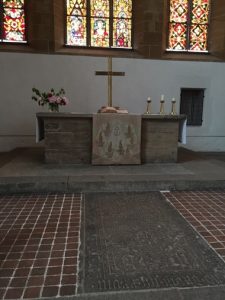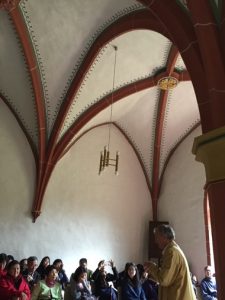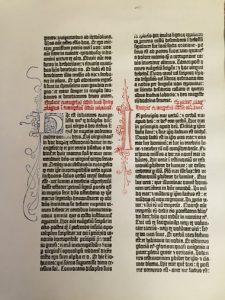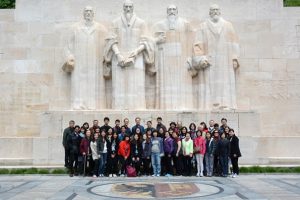REFORMATION PILGRIMAGE TESTIMONY: OF MAN, MACHINE AND MOVEMENT (I)
S M Wong
For almost 500 years, Protestants have used 1517 to mark the separation from the Roman Catholic Church when Martin Luther nailed his 95 Latin theses to the Castle Church door in Wittenberg, Germany. But Martin Luther was not the first to preach the Gospel. And we were only known as Protestants in 1529.
In 14th century England, John Wycliffe, considered to be Oxford University’s leading philosopher and theologian, had written on the biblical teaching on faith (salvation by faith alone) and challenged the sale of indulgences. Convinced that every Christian should have access to His Word in their native language, he started to translate the Bible into English. Although he died before the translation was completed, his friend, John Purvey finished the translation of what we now know as the “Wycliffe Bible”. Historians have called Wycliffe the “Morning Star of the Reformation”.
In 15th century Bohemia (modern day Czech Republic), Wycliffe’s works would influence John Huss, a Rector of Prague University, who also preached the Gospel at the Bethlehem Chapel (1402-1412) in Prague. At its peak, it was standing room only for 3000 worshippers. A prolific writer, he argued that Christ alone is head of the church, not the pope who can make many mistakes.
So why didn’t we date the Reformation to the 14th or 15th century instead? What was the game-changer which made it possible for Martin Luther to achieve what Wycliffe and Huss started but could not accomplish? With these in mind, my husband and I thank God for making it possible for us to go on Far Eastern Bible College’s Third Reformation Pilgrimage in the footsteps of Martin Luther and other reformers like John Calvin.
Martin Luther’s World
Martin Luther was born in Eisleben, Germany in 1483 into a world of tumultuous change. Politically, there was a desire to break away from the control of the Church when politics and religion became too intertwined. Culturally, the Renaissance saw a flourishing of ideas and innovations, in art and literature. The Dutch Humanist, Eramus published the landmark Greek New Testament (Textus Receptus) in 1516, on which Luther would translate the first German New Testament Bible later. The Textus Receptus symbolised the humanist desire to return to the original sources of the Scripture.
In Rome, the rebuilding of the St Peter’s Basilica which was started in 1506, was to be the emblem of the glory of papal Rome and how far the Church had veered from His Truth. To finance the expansion plans, the pope needed money – chest loads. So he granted the sale of indulgences to tap into the people’s superstitious beliefs of buying their way to heaven. In Wittenburg, we saw how indulgences were collected with treasure chests secured with three locks, no less.

An Indulgence Chest
The people were poor, both financially and spiritually because they had no access to the Bible and when His Word was read, it was in a language (Latin) they did not understand. Perhaps the Church did not want them to know the Truth to keep their enterprise going. This was particularly poignant when we visited the St Augustine’s Church and Monastery in Erfurt where Luther lived as an earnest young monk (1505-1511). According to our guide, the monks would recite the Latin Bible and beyond the veil in the sanctuary, believers would listen without comprehension. I found myself asking how much do I treasure God’s Word today, when it is readily accessible, written in a language I can understand. Yet, I wilfully choose not to understand or to selectively hear what I want to hear when the truth is too hard to bear.

Luther laid prostrate on this stone floor in the Augustinian church and monastery to take his vows to become a monk.
It was also here in the Chapter Room that the seeds of justification by faith alone was planted. What left an impression on me was how hard Luther tried to be a pious monk. Even before asking God for forgiveness, he would be making public confessions before his peers of sins that he had not committed. He was not angry with himself as one monk told Luther. He was angry with God. Salvation through good works did not give Luther any peace, only anguish.

Chapter Room in the Augustinian Monastery
Over the centuries, God raised brilliant men who studied and taught the Scripture. Through the work of Wycliffe and Huss who in turn would influence Luther, they were convicted to put the Scripture back into the hands of believers.
Martin Luther’s world was at inflection point, save for one crucial piece – the printing press.
The Facebook of 16th Century

A Printed Page from the Gutenberg Bible
Printing is not new. It is one of the four great Chinese inventions. In 1377, the Koreans printed the Jikji using a movable type system. Over in Mainz, Germany in 1450, Johannes Gutenberg made a mechanical metal movable-type printing press in Europe said to be inspired by the wine press. He was the first to create his type pieces from an alloy of lead, tin, and antimony. According to our guide, Gutenberg borrowed 800 guilders to fund his business. In 1455, he printed the Gutenberg Bible sold at 35 guilders or equivalent to a house then. In three to four years, he printed 180 bibles. Before Gutenberg’s printing press, it would take a monk three to five years to hand copy one Bible. As it was so expensive, not all churches had a copy. But Gutenberg’s printing days were short lived. He was made a bankrupt when he could not repay the business loan. Robbed of his idea and invention, the world was to gain a powerful tool of communication. It ignited not just the Protestant Reformation but helped spark the French Revolution in 18th century.

Reformation Pilgrims at the Reformation Monument (Geneva, Switzerland)
“Remember them which have the rule over you, who have spoken unto you the word of God: whose faith follow, considering the end of their conversation.” (Heb 13:7)

Reformation Pilgrims at the Reformation Monument (Geneva, Switzerland)


